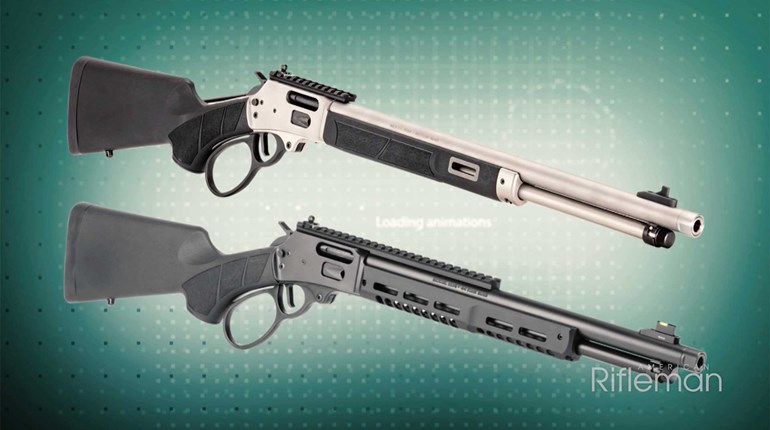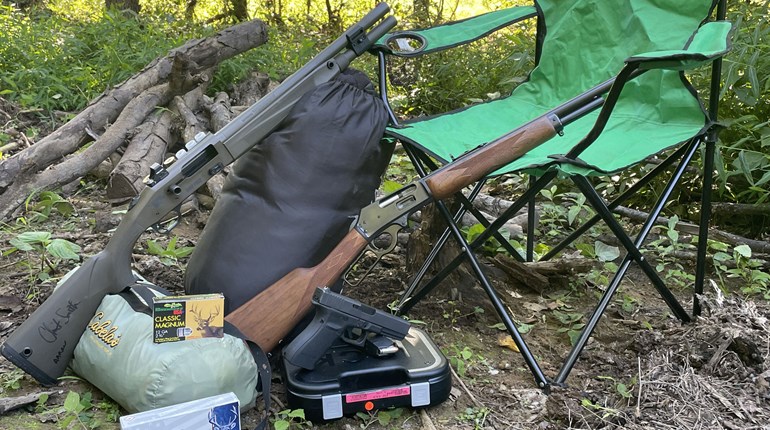
When it comes to recognizing and responding to a bear attack, few people have as much experience as Alaska’s Steve Nelson, a former research geologist for the U.S. Geological Survey who’s spent the last 41 years teaching bear defense courses in the Last Frontier. As a geologist, Nelson has killed four bears in defense of life and property (DLP), including two black bears and two grizzlies. Nelson continues to teach a bear defense course in Alaska, instructing geologists and representatives from other government agencies how to operate a wide variety of firearms platforms in a bear defense situation.
In terms of firearm selection, Nelson said it’s really about delivering a few well-placed shots on target in a short timeframe. The more energy and penetration the better, provided you don’t select a firearm that’s too powerful for you to adequately manage. As the bear charge drill in his course demonstrates, the average bear attack will happen at 50 yards or less with an 800-pound animal moving at 30 mph. At that distance, a shooter has roughly four seconds to make a charge-stopping shot, which requires a steady hand under intense pressure.

Among firearms platforms, a rifle delivers more energy and is effective to greater distances, making it the first choice. A 12-gauge shotgun and slug will deliver impressive energy and is effective to moderate ranges. A handgun is worn on your person, however, and is invaluable because it stays with you, whether you’re answering nature’s call or stopping to field dress a game animal. Like the Spartan’s xiphos blade, the handgun is a much shorter secondary weapon intended for up-close-and-personal encounters.
Over the decades, several cartridges have proved themselves as worthy against the nastiest bears North America has to offer. Here’s a look at the eight best charge-stopping bear cartridges ever made.

1. .45-70 Government
First adopted by the U.S. military in 1873, the .45-70 Government has been one of the longest-standing big-game cartridges of all time. It’s also been incredibly popular among Alaskan hunters and guides, especially in lever-actions like Marlin’s 1895 Guide Gun, which is compact, fairly lightweight and highly maneuverable in close quarters. It’s also capable of sending a massive projectile, like Buffalo Bore’s 430-grain hard-cast bullet, at roughly 2000 fps and 3,600 ft.-lbs. from the muzzle. Talk about stopping power.

2. .454 Casull
Developed by Dick Casull and Jack Fulmer in 1957, the .454 Casull is a dangerous game hunter’s dream come true. One of the more powerful handguns available today, the .454 is capable of pushing a 300-grain Buffalo Bore bullet at 1650 fps with 1,813 ft.-lbs. of energy at the muzzle. Nelson killed one of his charging grizzlies with a .454 Casull, which he says is one of his favorite choices for bear defense. Ruger chambers the .454 Casull in both the Super Redhawk with a 4-inch barrel and the Alaskan in a 3-inch variant, both of which are compact and easy to draw when things get up close and personal. Is it fun to shoot? Not at all. Nelson says after about 20 shots, his wrist starts to swell and he can no longer shoot. The beauty of the .454, however, is that you can practice with .45 Colt rounds and save yourself a bit of recoil trauma.

3. .44 Remington Magnum
Considered by many to be the minimum for big bear defense rounds, the .44 Remington Magnum was first introduced in 1955 for revolvers and gained widespread popularity in the 1970s thanks to Dirty Harry. While some may consider it the minimum, it’s plenty powerful enough to stop an onerous bear. A 240-grain +P Buffalo Bore projectile carries roughly 1,600 ft.-lbs. of energy at 1550 fps, which is more than double that of the 10mm and four times more energy than the 9mm. Available in shorter versions like the Smith & Wesson 629 with 4-inch barrel, the .44 Mag. has a well-deserved reputation as a charge-stopper.

4. .375 H&H Magnum
One of the original belted, rimless magnum rifle cartridges, Holland & Holland’s .375 is not only considered one of the best cartridges for hunting Africa, it also has a proven track record for lethality on large-bodied game in Canada and Alaska, including moose and bear. Popular among Alaskan guides and hunters, the .375 is capable of launching a 270-grain bullet at 4,300 ft.-lbs. and 2700 fps, thus delivering massive energy on target. As Nelson points out, the first shot may end the charge but doesn’t always kill the bear, which means it’s handy to have a rifle that can make the longer follow-up shot.

5. .50 Alaskan
Taking a .348 Winchester case and necking it out to accept a .510-inch, Alaskan Harold Johnson was able to successfully convert a Winchester Model 1886 rifle into a .50-caliber, bear-killing machine. The result, of course, was the .50 Alaskan. Buffalo Bore produces several loads for the .50 Alaskan, including a 450-grain bullet that delivers a whopping 4,400 ft.-lbs. of energy from the muzzle. As a wildcat cartridge, it hasn’t seen the widespread use of other rounds on this list, but that hasn’t stopped many guides and hunters, Nelson included, from converting Marlin lever guns for its very effective use.

6. 12-Gauge Slug
According to Nelson, the 12-gauge slug gun is by far one of the most popular choices for bear protection in the Alaskan bush. While it is extremely effective, the main reason it’s been so widely-used is because shotguns like the Remington 870 and Mossberg 500 are a fraction of the price of bolt-guns and, in turn, that’s what the government has provided to its employees. Based on ballistic testing and field use, Nelson recommends Brenneke’s Black Magic Magnum or DDupleks’ Monolit 32 solid steel slug. The Black Magic Magnum is a 602-grain slug that carries 3,000 ft.-lbs. of energy at 1500 fps, while the 495-grain DDupleks leaves the muzzle at 1410 fps with 2,180 ft.-lbs. of energy.

7. .338 Winchester Magnum
The favorite among Alaskan guides as a backup gun, the .338 Winchester Magnum was released in 1958 as belted, rimless cartridge. Based on the .375 H&H, the .338 will send a 300-grain Barnes bullet out the barrel at 2500 fps with a devastating 4,100 ft.-lbs. of energy. Considered by many to be the most versatile North American big-game cartridge, the .338 Win. Mag. has killed its fair share of charging bears. It’s chambered in nearly every major manufacturer’s rifle and has a plethora of ammunition choices as well.

8. .357 S&W Magnum
While some folks claim the .44 Magnum is the minimum for charging bears, many others have opted for a Glock 20 in 10mm Auto and, interestingly enough, passed right by the .357 S&W Magnum. Several folks have even successfully killed bears with a 9mm. While a well-placed shot from a 10mm can no doubt do the trick, the .357 Mag. has 780 ft.-lbs. of energy, while the 10mm has about 728 ft.-lbs., both with a 180-grain Buffalo Bore bullet. As Nelson has seen in bear defense training, many shooters have cycling issues with the 10mm due to the “limp-wrist syndrome,” something that isn’t an issue with a revolver and is the last thing you want to happen during a bear charge. The .357 is also available in smaller-framed revolvers that fit smaller hands, making it ideal for women and less experienced shooters. Any way you slice it, the .357 has proven itself as a worthy close-range bear stopper.





































